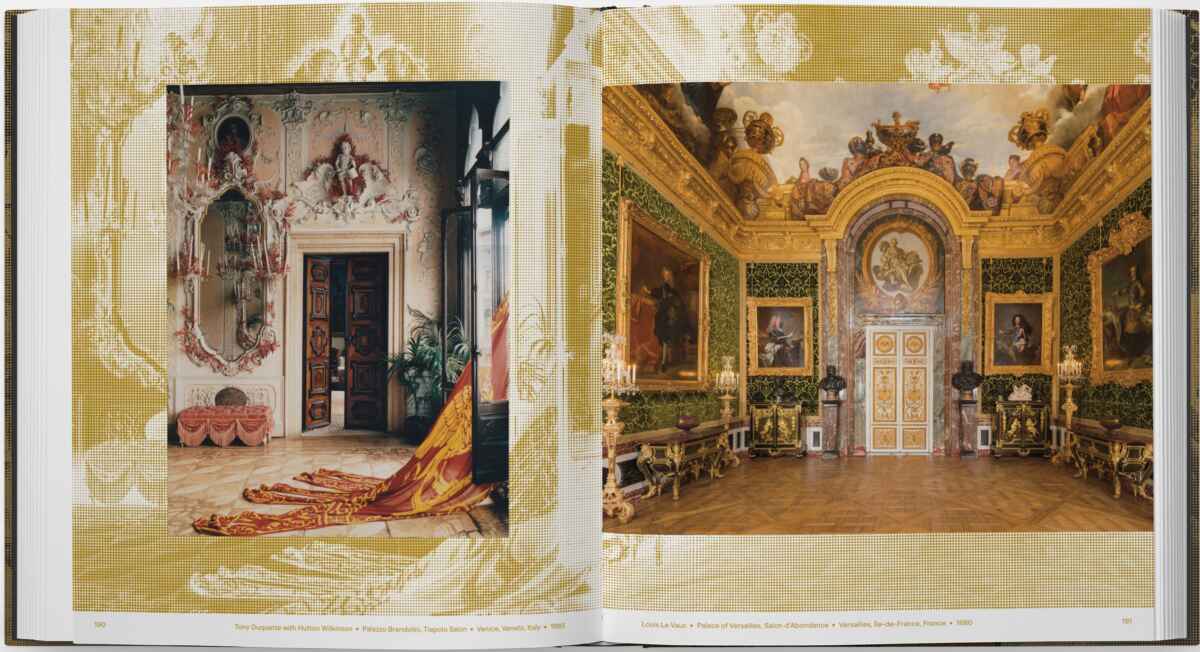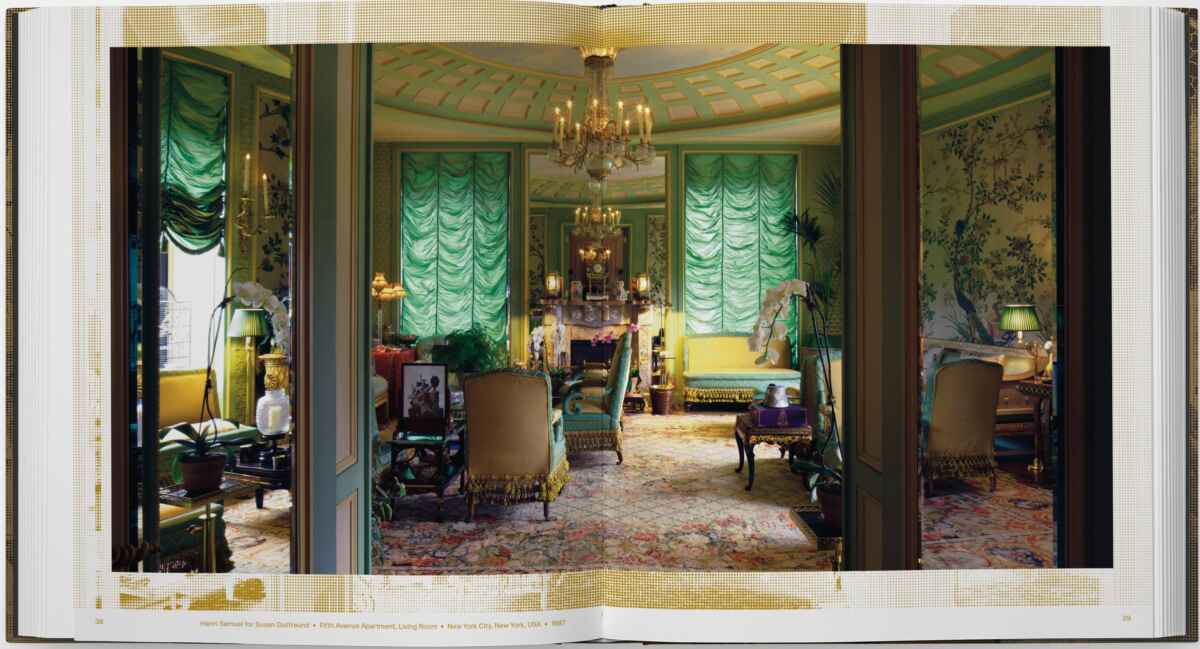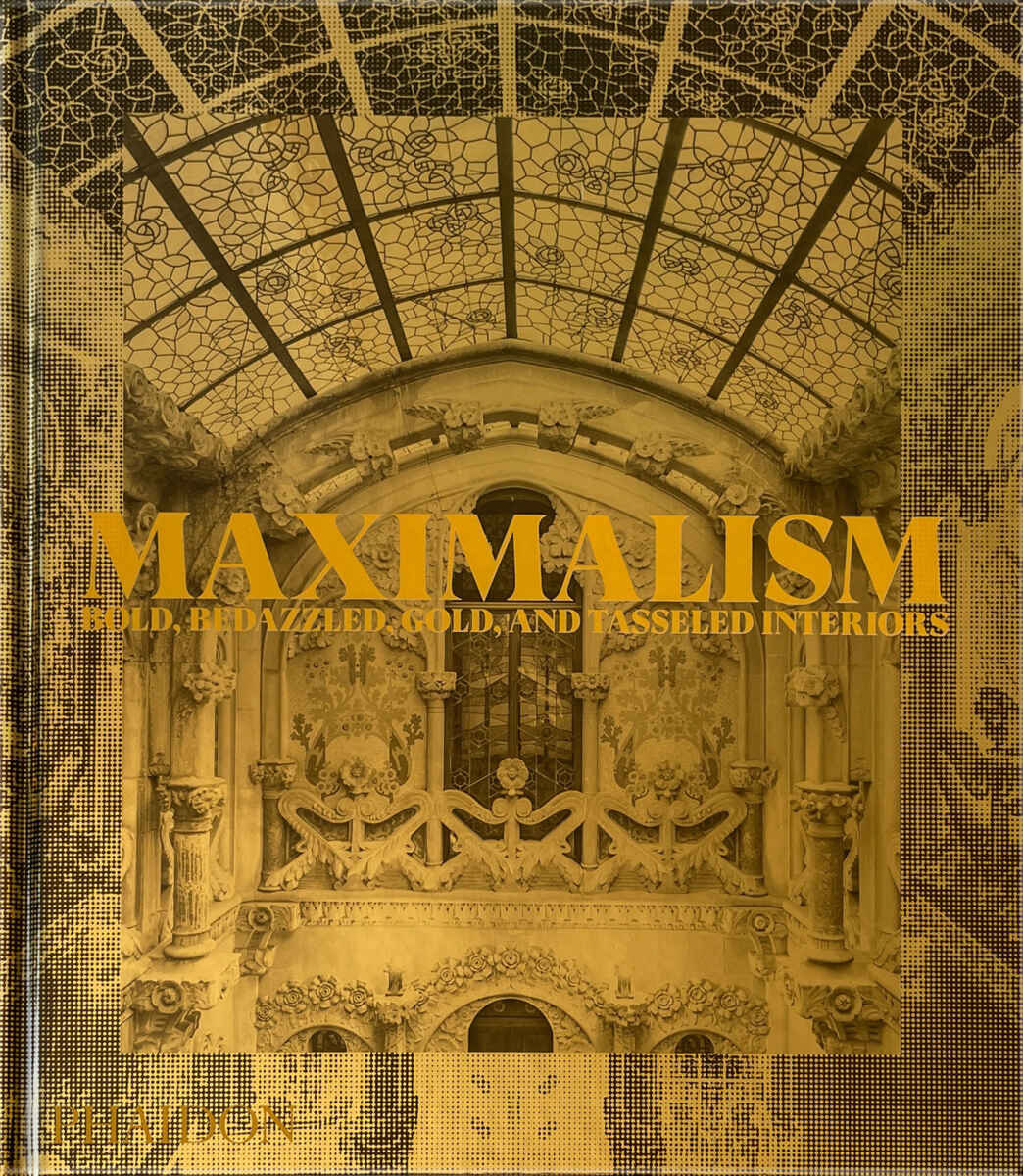
Maximalism in interior design means decadence, extravagance, excess and exuberance, If you love opulant, over the top, outrageously fabulous rooms, have a look at Maximalism. Bold, Bedazzled, Gold, and Tasseled Interiors by Phaidon Press Limited (Amazon.com, Amazon.co.uk, Amazon.fr, Amazon.de). On 288 pages, you can find over 220 maximalist residential interior photographs.
The introduction is by Simon Doonan (*1952), a famous window dresser and author, who designed the gallery set for the movie Beverly Hills Cop starring Eddie Murphy, appears in the Kim Carnes video for ‘Bette Davis Eyes’, worked for the legendary Diana Vreeland at The Costume Institute of the Metropolitan Museum in NYC before joining Barneys New York, where he worked from 1986 until 2019. In 1998, Simon Doonan published his memoir Confessions of a Window Dresser, which was his debut as a writer. His second memoir, Beautiful People (2008), became a BBC tv series.

The photographs (copyright © Phaidon Press) on the pages 190 and 191 of Maximalism (Amazon.com, Amazon.co.uk, Amazon.fr, Amazon.de) show, on the left, the work of the interior designers Tony Duquette and Hutton Wilkinson at Palazzo Brandolini, Coral Ballroom Venice, Veneto, Italy 1999. The photograph on the right features the work of Louis Le Vau (in the book misspelled “Le Vaux”) at the Palace of Versailles, Salon d’Abondance Versailles, Île-de-France, France 1680. Photograph copyright: Phaidon. The Baroque architect Louis Le Vau (1612-1670) is best-known for his work for the French King Louis XIV.
The designers who get most coverage in Maximalism are the stage, film and interior designer Tony Duquette (1914-1999) and his business partner and design collaborator of 30 years, Hutton Wilkinson. Wilkinson saved Tony and Elizabeth Duquette’s home Dawnridge. Built in Beverly Hills in 1949, it is one of America’s most photographed houses — and today’s headquarters for the Tony Duquette Studios, where Hutton Wilkinson serves as President and Creative Director.
In his introduction to Maximalism (Amazon.com, Amazon.co.uk, Amazon.fr, Amazon.de), Simon Doonan remembers the eccentric Tony Duquette and his extravagant home. He describes the improvisational use of found objects at Dawnridge, including a massively grandiose chandelier constructed from plastic drinking glasses and popsicle sticks. Simon Doonan notes that this rule-breaking eccentricity, a who-cares-what-the-neighbors-think mentality, is a common trait of the greatest maximalists. They have no desire to seek approval from others. Their goal is to hypnotize onlookers into a state of adoring submission.
According to Simon Doonan, like many maximalists presented in this tome, Louis XIV cast himself as a demi-god. He created the palace of Versailles with a castration strategy in mind. His goal was to neutralize the threat from the power-hungry regional aristocrats of France. Trapped in Louis’ dazzling whirligig, potential rivals were too busy shagging, powdering their wigs, and eating bonbons to stage a coup against the self-styled ‘Sun King.’
Tony Duquette was more of a wizard than a deity. Simon Doonan writes that one of the niftiest aspects of maximalism is the ability to torpedo reality. At the time of their encounter, Tony was in the midst of a late-life comeback. That might sound a little Norma Desmond—FYI, back in the day, Tony had been pals with Gloria Swanson, Greta Garbo, Louella Parsons, Fred Astaire and Marion Davies (not mentioned by Simon Doonan: they all attended his weeding ceremony, with Mary Pickford as matron of honor and Buddy Rogers as best man!), amongst others—but fashion brands and mags were shooting ad campaigns in Tony’s fantasy garden and his even more fantastical interior. Simon Doonan met Tony and his creative partner Hutton Wilkinson because they were looking for a retail partner to sell Tony’s gargantuan maximalist necklaces. Doonan was hoping that his employer, Barneys department store in New York, might seal the deal. One week later, as agreed, Simon called the designer and got what he wanted. Relief was followed by horror when Tony announced his one stipulation: ‘You must flood the main floor of the store with water and turn it into a lagoon. I want my jewelry displayed on floating lily pads. Real not fake.’ Was he joking? Of course he wasn’t. The point Simon Doonan wants to make with this anecdote is that a true maximalist is not only a visionary but also a fabulously uncompromising interior designer. As a result, maximalism has always left a trail of tassels and tears.
In Maximalism, the following interior designs by Tony Duquette and Hutton Wilkinson Dawnridge are featured: Garden Room Beverly Hills, California, USA 1955 (page 40); Drawing Room Beverly Hills, California, USA 1955 (page 76); Wilshire Corridor Penthouse, Sitting Area Los Angeles, California, USA 2020 (page 151); Palazzo Brandolini, Coral Ballroom Venice, Veneto, Italy 1999 (page 183); Palazzo Brandolini, Coral Ballroom Venice, Veneto, Italy 1999 (page 190); Duquette Ranch, ‘Sortelegium’, Tea House Malibu, California, USA 1995 (page 216); and Manhattan Penthouse, Dining Room New York City , New York, USA 2019 (page 231).

The double page 38-39 of Maximalism shows the Living Room of Susan Gutfreund’s Fifth Avenue Apartment in New York City, NY, USA, designed by Henri Samuel in 1987 (photograph copyright © Phaidon Press). Order Maximalism from Amazon.com, Amazon.co.uk, Amazon.fr, Amazon.de.
For Simon Doonan, the history of maximalism is entwined with tyranny and imperialism. He writes about Egyptian pyramids, the Versailles madness of the Sun King and the mega wealth of the Victorian Age produced explosions of showy-offy interior design on both sides of the Atlantic.
According to Simon Doonan, maximalism is no longer just about dough. In parallel with the glam palaces of the mega rich, a new generation of outsiders is creating sensational interiors using yard-sale furniture and Duquette-ian techniques that were more often found in window displays: decoupage, upcycling, hacking, collage, badinage, and lots of paint. He suggests that you should check in to Trixie Mattel’s Trixie Motel, and celebrate the democratization of maximalism.
For him, maximalism is a positive force because it fosters artisanal creativity. Without maximalists, the world would be at the mercy of minimalists—quelle horreur!

This photograph, also featured on top of this article, shows the maximalist interior design by Rouge Absolu for a Paris Apartment, Dining Room, Paris, France, 2017. Picture credit: © Francis Amiand (page 111).
Maximalism transcends time and geography. It’s not about following aesthetic rules. It’s more about attitude and style. This books includes interior designs from the 17th century to the present.
Maximalism offers strong emotions and humour. Among the recurrent tropes that can be spotted in this book’s photographs, the editors mention bombastic use of colors, patterns, prints, tapestries, sequins, ruffles, fringes, rugs, pillows, cushions, canopies, gilt-edged everything, layer upon layer of art, and objet, swags of fabric on every viable surface, not to mention a whole safari’s worth of leopard, tiger, and zebra motifs. Always more. Never less.
Maximalism. Bold, Bedazzled, Gold, and Tasseled Interiors. Introduction by Simon Doonan. Phaidon, October 2023, 288 pages with over 220 maximalist residential interior photographs. Order this perfect coffee table book from Amazon.com, Amazon.co.uk, Amazon.fr, Amazon.de.

For a better reading, quotations and partial quotations in this review of Maximalism. Bold, Bedazzled, Gold, and Tasseled Interiors have not been put between quotation marks.
Maximalist interior design book review added on October 4, 2023 at 11:24 Swiss time. Detail added at 16:39.